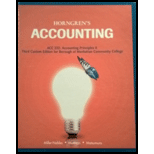
ACCOUNTING PRINCIPLES 222 5/16 >C<
2nd Edition
ISBN: 9781323461525
Author: Horngren
Publisher: PEARSON C
expand_more
expand_more
format_list_bulleted
Concept explainers
Textbook Question
Chapter 9, Problem S9.9SE
Computing interest amounts on notes receivable
A cable of notes receivable for 2016 follows:
| Principal | Interest Rate | Interest Period During 2016 | |
| Note 1 | $ 30,000 | 4% | 3 months |
| Note 2 | 8,000 | 5% | 180 days |
| Note 3 | 28,000 | 12% | 90 days |
| Note 4 | 110,000 | 10% | 6 months |
For each of the notes receivable, compute the amount of interest revenue earned during 2016. Round to the nearest dollar.
Expert Solution & Answer
Want to see the full answer?
Check out a sample textbook solution
Students have asked these similar questions
Can you help me solve this general accounting question using valid accounting techniques?
Please provide the solution to this general accounting question using proper accounting principles.
Please explain the solution to this general accounting problem with accurate explanations.
Chapter 9 Solutions
ACCOUNTING PRINCIPLES 222 5/16 >C<
Ch. 9 - 1. With good internal controls, the person who...Ch. 9 - Prob. 2QCCh. 9 - Which of the following is a limitation of the...Ch. 9 - 3. The entry to record a write-off of an...Ch. 9 - Brickman Company uses the allowance method to...Ch. 9 - Brickman’s ending balance of accounts Receivable...Ch. 9 - At December 31 year-end, Crain Company has an...Ch. 9 - Using the data in the preceding question, what...Ch. 9 - At year-end, Schultz Company has cash of $11,600,...Ch. 9 - Using the data in the preceding question, assume...
Ch. 9 - What is the difference between accounts receivable...Ch. 9 - List some common examples of other receivables,...Ch. 9 - Prob. 3RQCh. 9 - When dealing with receivables, give an example of...Ch. 9 - What type of account must the sum of all...Ch. 9 - Prob. 6RQCh. 9 - What occurs when a business factors its...Ch. 9 - What occurs when a business pledges its...Ch. 9 - What is the expense account associated with the...Ch. 9 - When is bad debts expense recorded when using the...Ch. 9 - What are some limitations of using the direct...Ch. 9 - Prob. 12RQCh. 9 - Prob. 13RQCh. 9 - When using the allowance method, what account is...Ch. 9 - Prob. 15RQCh. 9 - Prob. 16RQCh. 9 - How do the percent-of-receivables and...Ch. 9 - What is the difference between the...Ch. 9 - In accounting for bad debts, how do the income...Ch. 9 - What is the formula to compute interest on a note...Ch. 9 - Prob. 21RQCh. 9 - Prob. 22RQCh. 9 - Prob. 23RQCh. 9 - Prob. 24RQCh. 9 - Prob. S9.1SECh. 9 - Prob. S9.2SECh. 9 - Applying the direct write-off method to account...Ch. 9 - Collecting a receivable previously written...Ch. 9 - Applying die allowance method to account for...Ch. 9 - Applying the allowance method (percent-of-sales)...Ch. 9 - Applying the allowance method...Ch. 9 - Applying the allowance method...Ch. 9 - Computing interest amounts on notes receivable A...Ch. 9 - Accounting for a note receivable On June 6,...Ch. 9 - Accruing interest revenue and recording collection...Ch. 9 - Recording a dishonored note receivable Midway...Ch. 9 - Using the acid-test ratio, accounts receivable...Ch. 9 - Defining common receivables terms Learning...Ch. 9 - E9-15 Identifying and correcting internal control...Ch. 9 - Journalizing transactions using the direct...Ch. 9 - Prob. E9.17ECh. 9 - Prob. E9.18ECh. 9 - Accounting for uncollectible accounts using the...Ch. 9 - Prob. E9.20ECh. 9 - Prob. E9.21ECh. 9 - Journalizing note receivable transactions...Ch. 9 - Journalizing note receivable transactions The...Ch. 9 - Journalizing note receivable transactions Like New...Ch. 9 - Evaluating ratio data Chippewa Carpets reported...Ch. 9 - Prob. E9.26ECh. 9 - Accounting for uncollectible accounts using the...Ch. 9 - Accounting for uncollectible accounts using the...Ch. 9 - Accounting for uncollectible accounts using the...Ch. 9 - Prob. P9.30APGACh. 9 - Accounting for notes receivable and accruing...Ch. 9 - Accounting for notes receivable, dishonored notes,...Ch. 9 - Prob. P9.33APGACh. 9 - Prob. P9.34BPGBCh. 9 - Prob. P9.35BPGBCh. 9 - Prob. P9.36BPGBCh. 9 - Prob. P9.37BPGBCh. 9 - Prob. P9.38BPGBCh. 9 - Prob. P9.39BPGBCh. 9 - Prob. P9.40BPGBCh. 9 - Prob. P9.41CPCh. 9 - Accounting for uncollectible accounts using the...Ch. 9 - Decision Case 9-1 Weddings on Demand sells on...Ch. 9 - Decision Case 9-2 Pauline’s Pottery has always...Ch. 9 - Prob. 9.1FCCh. 9 - > Financial Statement Case 9-1 Use Starbucks...
Knowledge Booster
Learn more about
Need a deep-dive on the concept behind this application? Look no further. Learn more about this topic, accounting and related others by exploring similar questions and additional content below.Similar questions
arrow_back_ios
SEE MORE QUESTIONS
arrow_forward_ios
Recommended textbooks for you
- Principles of Accounting Volume 1AccountingISBN:9781947172685Author:OpenStaxPublisher:OpenStax College
 Financial Accounting: The Impact on Decision Make...AccountingISBN:9781305654174Author:Gary A. Porter, Curtis L. NortonPublisher:Cengage Learning
Financial Accounting: The Impact on Decision Make...AccountingISBN:9781305654174Author:Gary A. Porter, Curtis L. NortonPublisher:Cengage Learning Financial AccountingAccountingISBN:9781305088436Author:Carl Warren, Jim Reeve, Jonathan DuchacPublisher:Cengage Learning
Financial AccountingAccountingISBN:9781305088436Author:Carl Warren, Jim Reeve, Jonathan DuchacPublisher:Cengage Learning

Principles of Accounting Volume 1
Accounting
ISBN:9781947172685
Author:OpenStax
Publisher:OpenStax College

Financial Accounting: The Impact on Decision Make...
Accounting
ISBN:9781305654174
Author:Gary A. Porter, Curtis L. Norton
Publisher:Cengage Learning

Financial Accounting
Accounting
ISBN:9781305088436
Author:Carl Warren, Jim Reeve, Jonathan Duchac
Publisher:Cengage Learning
The ACCOUNTING EQUATION For BEGINNERS; Author: Accounting Stuff;https://www.youtube.com/watch?v=56xscQ4viWE;License: Standard Youtube License